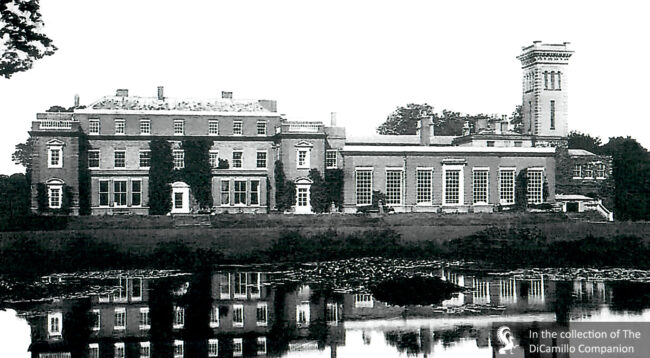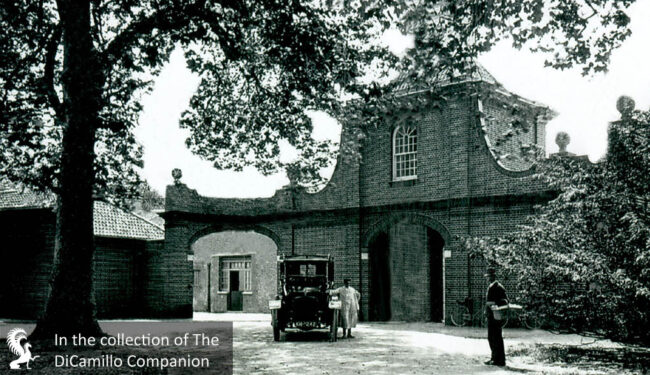
The house from a circa 1910 postcard

Stable entrance from a circa 1920 postcard
Built / Designed For: Wilson family
House & Family History: Didlington was built in phases: the west wing was erected in the 17th century, the south facade was of 1774, the north facade was added in 1816, the Italianate east wing and tower were from 1856, while the rebuilding of the house in the Georgian style was carried out between 1883 and 1885. The British Army occupied the house during World War II, when it was the headquarters of General Miles Dempsey, commander of the British Second Army. The house never recovered from the army's occupation; in April 1950 most of Didlington Hall's fixtures (doors, chimneypieces, paneling, staircases, and architectural elements) were sold and the house began to be demolished.
House Replaced By: In 2007 a new house was built on the site of the 17th century house.
Collections: In the 19th century the 1st Baron Amherst created an important collection of art at Didlington. Though the assemblage was rich in tapestries, rare books, and paintings, it was the collection of Egyptian objects that brought the most attention. The Egyptology collection, which grew so large that Lord Amherst erected a specially-built museum building to house it, attracted many famous visitors, including the Prince of Wales (later Edward VII). One of the artists Lord Amherst engaged was the painter Samuel John Carter, who brought his young son, Howard, with him to Didlington while he worked. Lord Amherst later became a patron of Howard Carter, who went on to become an archaeologist and the discoverer of King Tut's tomb. In December of 1908, barely a month before his death, most of Lord Amherst's book and manuscript collection was sold by Sotheby's. The noted collector J.P. Morgan purchased the King Charles I copy of the Cambridge bible (for $5,000) and 16 Caxtons (for $500,000) by private treaty just before the sale. In March 1909 even more lots, including a Gutenberg bible, were auctioned, eviscerating the important library.
Garden & Outbuildings: At its height in the 19th century, the Didlington Hall Estate spanned 7,100 acres. In 2023 Park Cottage, a former estate building that was once the home of Didlington's farm manager, was listed for sale for £500,000.
Architect: Richard Norman Shaw
Date: 1883-85Architect: Unknown (designed by an unknown architect)
Date: 17th centuryArchitect: Unknown (designed by an unknown architect)
Date: 1816Architect: Unknown (designed by an unknown architect)
Date: 1856
Title: Burke's & Savills Guide to Country Houses, Volume III: East Anglia
Author: Kenworthy-Browne, John; Reid, Peter; Sayer, Michael; Watkin, David
Year Published: 1981
Reference: pgs. 103-104
Publisher: London: Burke's Peerage
ISBN: 0850110351
Book Type: Hardback
House Listed: Demolished
Park Listed: Not Listed
Past Seat / Home of: Robert Wilson, 9th Baron Berners, until 1838; Henry Wilson, 10th Baron Berners, 1838-46; Wilson family here from the 17th century until 1846. Lord William Powlett, 1846-52. William George Tyssen-Amherst, 1852-55; William Amhurst Tyssen-Amherst, 1st Baron Amherst of Hackney, 1855-1909; Mary, Baroness Amherst, 1909-10. Col. Herbert Francis Smith, 1911-49.
Current Ownership Type: Demolished
Primary Current Ownership Use: Demolished
House Open to Public: No
Historic Houses Member: No